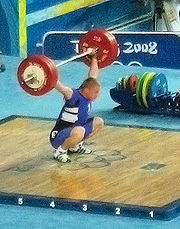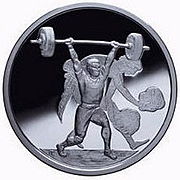- Olympic weightlifting
-
This article is about the sport of weightlifting. For the muscle-building activity involving weights, see weight training. For using weights to develop physique, see bodybuilding.
Olympic Weightlifting, also called Olympic-style weightlifting, or weightlifting, is an athletic discipline in the modern Olympic programme in which participants attempt a maximum-weight single lift of a barbell loaded with weight plates.
The two competition lifts in order are the Snatch and the Clean and Jerk. Each weightlifter receives three attempts in each and the combined total of the highest two successful lifts determines the overall result within a bodyweight category. Bodyweight categories are different for women and men. A lifter who fails to complete at least one successful Snatch and one successful Clean and Jerk also fails to 'total' and therefore receives an 'incomplete' entry for the competition. The Clean and Press was once another competition lift but was discontinued due to difficulties in judging proper form.
In comparison with other strength sports which test limit strength (with or without lifting aids), Olympic Weightlifting tests aspects of human ballistic limits (explosive strength) and are therefore executed faster - and with more mobility and a greater range of motion during their execution - than other lifts. The Snatch and Clean and Jerk are both dynamic and explosive while appearing graceful, especially when viewed from a recording at a slowed speed.
While there are relatively few competitive Olympic weightlifters (or more simply lifters), the lifts and their components are commonly used by elite athletes in other sports to train for both explosive and functional strength.
Contents
Competition
The sport is controlled by the International Weightlifting Federation (IWF). Based in Budapest, it was founded in 1905. Male athletes compete in one of eight divisions, and female athletes lift in one of seven divisions determined by their body mass. The men's classes are:
- 56 kg (123 lb)
- 62 kg (137 lb)
- 69 kg (152 lb)
- 77 kg (170 lb)
- 85 kg (187 lb)
- 94 kg (207 lb)
- 105 kg (231 lb)
- and over 105 kg;
And the women's are:
- 48 kg (106 lb)
- 53 kg (117 lb)
- 58 kg (128 lb)
- 63 kg (139 lb)
- 69 kg (152 lb)
- 75 kg (165 lb)
- and over 75 kg.[1]
In each weight division, lifters compete in both the Snatch and Clean and Jerk and prizes are usually given for the heaviest weights lifted in the Snatch, the Clean and Jerk and the Overall - the two lift totals combined. The order of the competition is up to the lifters – the competitor who chooses to attempt the lowest weight goes first. If they are unsuccessful at that weight, they have the option of reattempting at that weight or trying a heavier weight after any other competitors have made attempts at the previous weight or any other intermediate weights. The barbell is loaded incrementally and progresses to a heavier weight throughout the course of competition. Weights are set in 1 kilogram increments and each lifter has a maximum of three attempts in each of the two lifts, regardless of whether they are successful or not.[1]
During competition, the Snatch event takes place first, followed by a short intermission, and then the Clean and Jerk event follows-on. There are two side judges and one head referee who together provide a "successful" or "failed" result for each attempt based on their observation of the lift within the governing body's rules and regulations. A majority of two "successes" is required for any attempt to pass. Usually, the judges' and referee's results are registered via a lighting system with a white light indicating a "successful" lift and a "red" light indicating a "failed" lift. This is done for the benefit of all in attendance be they athlete, coach, administrator or audience.
Also, a "Best Lifter" title is commonly awarded at local competitions. It is awarded to both the best men's and women's lifters. The award is based on a formula which employs the "Sinclair Coefficient", a coefficient derived and approved by the sport's world governing body and which allows for differences in both gender and bodyweight. When the formula is applied to each lifter's overall total and then grouped along with the other competitors' and evaluated, it provides a numeric result which determines the competition's best overall men's and women's lifters. [2] And while, usually, the winner of the heaviest weight class will have lifted the most overall weight during the course of a competition, a lifter in a lighter weight class may still have lifted more weight both relative to his or her own bodyweight and to the Sinclair Coefficient formula thereby garnering the "Best Lifter" award.
History
Men's weightlifting has been an Olympic sport for many decades. Recently, women's weightlifting has become a recognized Olympic sport, although as early as 1987, there were official world championships awarded to women weightlifters such as Karyn Marshall.[3][4][5] In 2011 the International Weightlifting Federation ruled that athletes could wear a full-body "unitard" under the customary weightlifting uniform. [6] Kulsoom Abdullah became the first woman to do so at the U.S. national championships that year, and athletes are allowed to do so at the Olympics. [7] IWF rules previously stated that an athlete's knees and elbows must be visible so officials can determine if a lift is correctly executed. [8]
See also
- World Weightlifting Championships
- Weightlifting at the Summer Olympics
- List of world records in Olympic weightlifting
- List of Olympic records in weightlifting
- List of Olympic medalists in weightlifting
- List of Olympic weightlifters of the United States
- U.S. intercollegiate weightlifting champions
- Powerlifting
- Paralympic powerlifting
References
- ^ a b "IWF Technical and Competition Rules" (PDF). International Weightlifting Federation. http://www.iwf.net/doc/Technical&CompRules2009-2012.pdf. Retrieved 2009-08-10.
- ^ "The Sinclair Coefficients for the Olympiad". International Weightlifting Federation. http://www.iwf.net/iwf/weightlifting_sport/sinclair.php. Retrieved 2009-07-24.
- ^ "The History of Weightlifting". teamUSA.org. 2009-10-02. http://weightlifting.teamusa.org/pages/1400. Retrieved 2009-10-02.
- ^ Michael Janofsky (November 16, 1987). "Olympic Notebook: 7 Unlikely Nations Join Winter Games". The New York Times. http://www.nytimes.com/1987/11/16/sports/olympic-notebook-7-unlikely-nations-join-winter-games.html. Retrieved 2009-10-02.
- ^ Julie Carft (July 29, 1989). "Image is Heavy Burden - Weightlifter Karyn Marshall Feels Pressure to Project 'Femininity, Intelligence'". Los Angeles Times. http://articles.latimes.com/1989-07-29/sports/sp-145_1_karyn-marshall. Retrieved 2009-10-02.
- ^ http://espn.go.com/olympics/weightlifting/story/_/id/6773853/muslim-woman-kulsoom-abdullah-makes-history-weightlifting-event
- ^ http://espn.go.com/olympics/weightlifting/story/_/id/6773853/muslim-woman-kulsoom-abdullah-makes-history-weightlifting-event
- ^ http://espn.go.com/olympics/weightlifting/story/_/id/6773853/muslim-woman-kulsoom-abdullah-makes-history-weightlifting-event
External links
Strength sports Strength athletics • World's Strongest Man • Strongman • Bodybuilding • Natural bodybuilding • Olympic weightlifting • Clean and jerk • Snatch • Clean and press
See also: Weight training Olympic sports Summer sports Archery • Athletics • Badminton • Basketball • Boxing • Canoeing • Cycling • Diving • Equestrian • Field hockey • Fencing • Football • Gymnastics • Handball • Judo • Modern pentathlon • Rowing • Sailing • Shooting • Swimming • Synchronized swimming • Table tennis • Taekwondo • Tennis • Triathlon • Volleyball • Water polo • Weightlifting • Greco-Roman Wrestling
Winter sports Former Olympic sports Baseball • Basque pelota • Cricket • Croquet • Golf • Jeu de paume • Lacrosse • Polo • Rackets • Roque • Rugby union • Softball • Tug of war • Water motorsports
Part of the 2016 program See also: Paralympic sports Categories:- Weightlifting
- Individual sports
- Olympic sports
Wikimedia Foundation. 2010.



